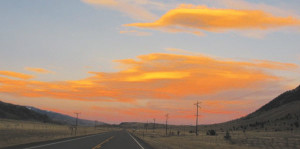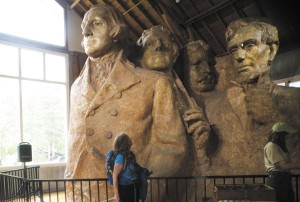In this past February’s article, I told you my sister Gail and I take a trip together, just the two of us, every five or six years. She lives in Oakland, California and we only get to see each other a couple of times a year during hurried family events. This year we went out West and this is Day Five of our adventure.
We had a great time at the wedding the night before and like most parties we attend we were one of the last to leave — we danced all evening. Luckily our cabin was only a mile down the road from the reception.
The next morning we packed up knowing we needed to go all the way across Montana to the west side of Yellowstone that day. We had a room booked in my sister’s time share. You usually have to book a stay there a year in advance, but being a huge resort lodge-like building that had over a hundred suites, she was able to get a spot (there is always a cancellation but they never know until that day).
Since we had only seen Mt. Rushmore from lookout vistas and in the dark the first night in South Dakota, we decided we really needed to see it close up.
The National Park is beautifully maintained, and it had all the bells and whistles — restaurants, gift shops galore and a museum.
The front gates and entry way are quite impressive with tall pillars lining this long walkway with flags displayed from every state in the union. Off to the right is a museum with state of the art exhibits of how this massive sculpture was created. There were displays of the tools used to carve out the sculpture and videos of the actual work being done — what a tedious job they had. The carving involved the use of dynamite, followed by the process of “honeycombing,” where workers drilled holes close together, allowing small pieces to be removed by hand with a chisel.
A huge outdoor amphitheater is at the end of the long walkway and the walkway off to the left leads you around to the base of the of the huge monument. At each viewing platform were informational signs and we purchased the audio tour on headphones which were very informative. The faces look so different from different angles.
We stopped at The Sculptor’s Studio that houses the huge plaster model the sculptor Borghum created. The scale is 1 inch equals 1 foot of the monument.
My sister and I stopped in the huge cafeteria and had Buffalo Burgers which were delicious! I told Gail we had an 11 hour drive to Yellowstone and it was 3 in the afternoon, so we needed to get started and we left.
The 11 hour drive across Montana was so peaceful and so beautiful. There is a lot of sky when you drive through that sparsely populated state. I remember years ago sitting on a plane next to a young fellow on his way to interview for a job in Indianapolis from Montana and he said there were more people inside I-465 in Indy than in all of Montana. He had graduated from college and didn’t want to raise cattle so he was traveling to all the major cities looking for a good job.
Luckily the time share we were staying in stays open 24/7 because we rolled into the western side of Yellowstone (actually in Idaho) at 2 a.m. Near Yellowstone we had to come to a stop because there were three deer just standing in the middle of the road. At the time share we stayed in a small apartment, with full kitchen, fireplace, patio and I slept in a Murphy bed I pulled out of the wall.
CORRECTION: I had a reader email me that you actually can get the National Parks lifetime pass when you are 62 years old (not 65) for $10.
Here’s a little background history of Mt. Rushmore:
In 1924, South Dakota had been a state only 35 years and to encourage some tourism, state historian Doane Robinson proposed creating sculptures of western heroes out of the Black Hills rock formations known as the Needles. He thought sculptures like Red Cloud, Lewis & Clark and Buffalo Bill would bring the tourists in. So he wrote a letter to the world renowned artist Gutzon Borghum who had sculpted a well known bust of Lincoln. He started out as a painter and then had studied with Rodin in Paris and switched to sculpture. Borghum agreed but changed Robinson’s idea from western figures to Presidents that would have a wider national appeal. He decided the Needles were not suitable for the project so he found the flat-topped 6,000 ft. granite Mount Rushmore which had southern exposure for better lighting all day. The only problem was that it was a mile and a half from the nearest road and was going to take a lot of funding to create. Washington and Lincoln were easy choices for the monument, but Borghum wanted it bigger and picked Jefferson for the third figure. The fourth choice was controversial and Borghum decided on Roosevelt even though Woodrow Wilson was also a choice. After Washington and Lincoln were finished in 1937, a bill was introduced in Congress to add the head of women’s-rights leader Susan B. Anthony, but a rider was passed on an appropriations bill requiring federal funds be used to finish only those heads that had already been started at that time.
With federal funding the project was started in 1927 and lasted 14 years.
Borghum made a plaster model which is on display in a studio on the grounds of the National Memorial. Originally they were to be sculpted to the waist but a lack of funding forced construction to end late Oct. 1941, weeks before Pearl Harbor. Borghum died before completion and his son Lincoln Borghum finished the sculpture. It took 400 workers to create these 60 ft. high carvings with no fatalities.
Today 2 million people visit Mt. Rushmore yearly.
Thus ended Day Five of a nine day adventure. Next time, I’ll write about Yellowstone paula.weeklyview@yahoo.com




